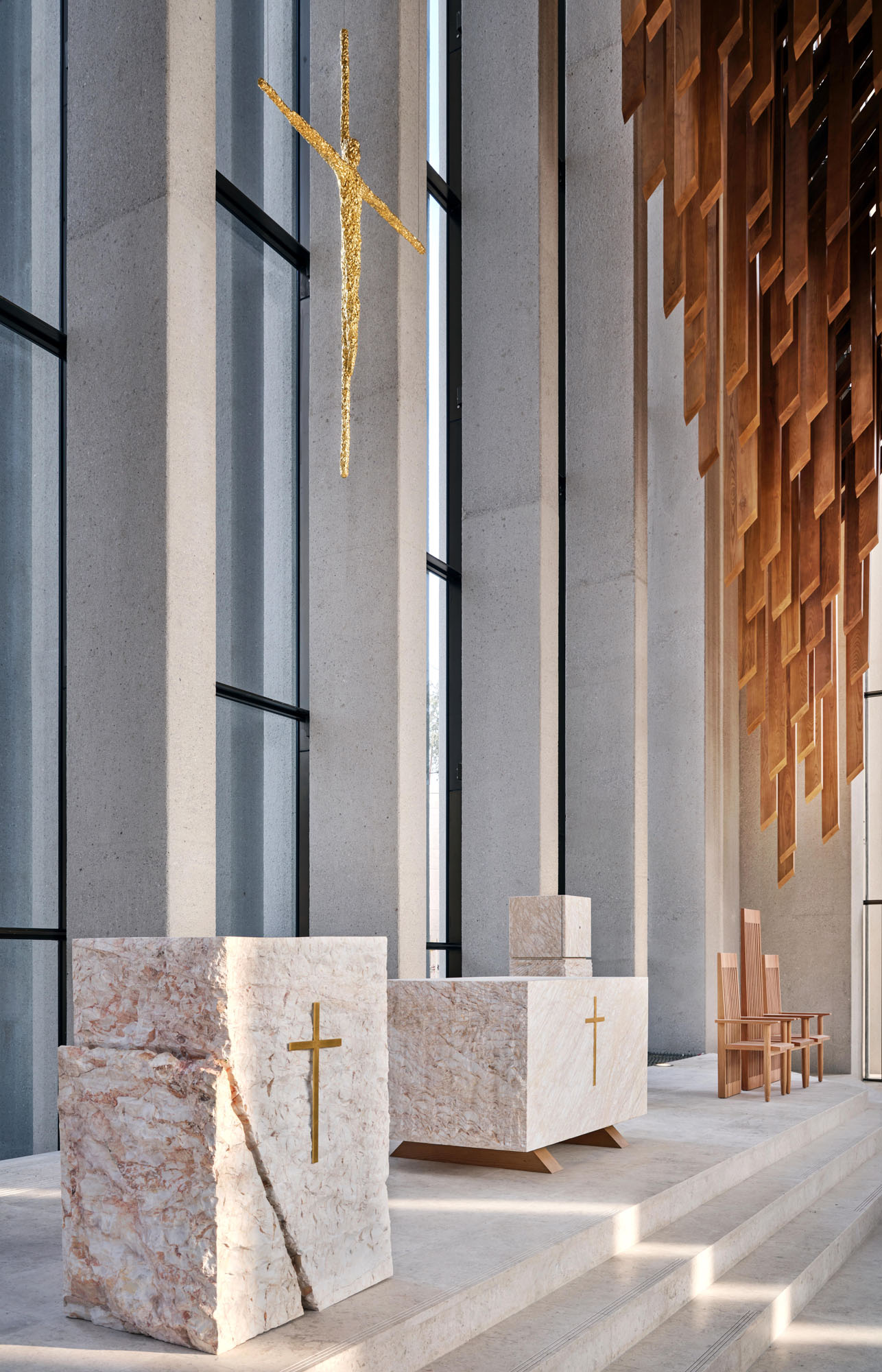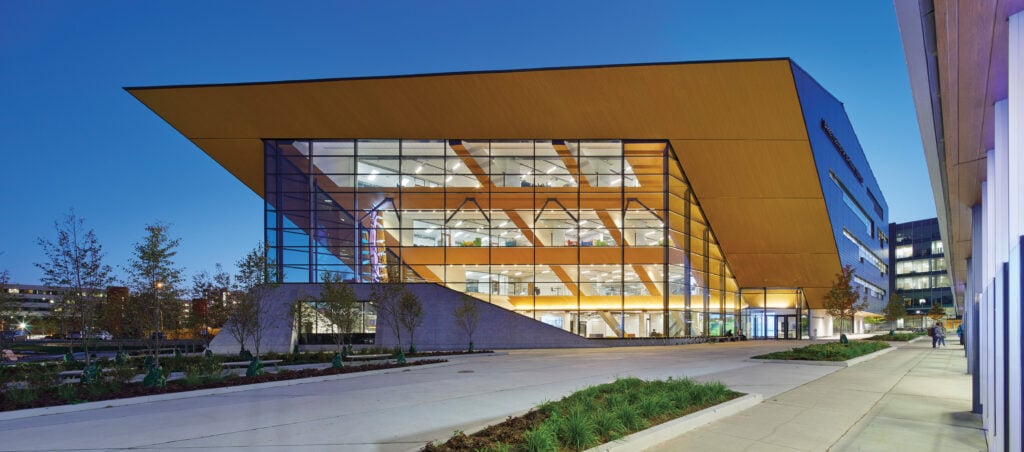
June 8, 2023
David Adjaye’s Abrahamic Family House Is a Monument to Soft Power
Saadiyat Island, translated as “the Island of Happiness,” is an exclusive enclave in the Emirate of Abu Dhabi lined with luxury apartment buildings, high-end hotels and one of Conde Nast’s top-rated beaches in the Middle East. Unlike in the neighboring Emirate of Dubai where new development takes the form of over-the-top glitz, Saadiyat Island bills itself as a global cultural destination. Development is (comparatively) restrained and comes with a host of environmental sustainability initiatives and grand architectural ambitions. More than six cultural mega projects are on the drawing boards or already built, including the recently completed Abu Dhabi Louvre designed by Jean Nouvel and the soon-to-be-completed Abu Dhabi Guggenheim designed by Frank Gehry.
However, the most significant symbol of Abu Dhabi’s lofty aspirations for the island, is the Abrahamic Family House designed by RIBA Royal Gold Medal winner David Adjaye, which opened this past March and features prominently in a major exhibition of the architect’s work in the 2023 Venice Architecture Biennale. The complex by the British-Ghanian architect includes an interdenominational church, a mosque, and the first purpose-built synagogue in modern times in the United Arab Emirates (U.A.E.), where until the signing of the landmark Abraham Accords in 2020, Israeli citizens were persona non-grata.

The Dark Side of Abu Dhabi’s Cultural Explosion
The opening of The Abrahamic Family House comes at a time when the U.A.E., which the oil rich Emirate of Abu Dhabi dominates, is seeking to cement its status as a cosmopolitan center for international business and tourism. The religious complex’s debut also is directly linked to the 2019 signing of the “Document on Human Fraternity for World Peace and Living Together,” signed in the U.A.E., which stresses compassion for the poor, human rights and the building of bridges to other cultures and faiths).
However, recent reports alleging widespread human rights abuses within Abu Dhabi and investigative articles in the Western press raise troubling questions about how tolerant the country really is. The U.A.E., after all, is ruled by a confederation of autocratic monarchies and is a country where almost 90 percent of the population consists of foreigners, many of whom are migrant workers from South Asia and suffer frequent passport confiscations, irregular or non-payment of wages, and are often literally confined in squalid labor camps, far from the luxurious splendor of Saadiyat Island.
Museums and hotels on Saadiyat Island have been cited for enabling an environment where there have been alleged widespread abuses inflicted on construction workers who labor under conditions that have been compared to as modern slavery. “Establishments that would be deemed to be “Western” or “Humanitarian” tend to adapt quite rapidly to the inhumane norms of the U.A.E., according to an article in Harvard International Review, “when employees are mistreated in a foreign country, far away from the safety of the protective laws and regulations of countries like the United States, the United Kingdom, or France, these Western establishments tend to remain disappointingly quiet.”

Building Common Ground for the Three Abrahamic Religions
David Adjaye says that he is not “a political person” and that for him The Abrahamic Family House was an unprecedented opportunity to provide architectural healing for historic religious rifts. “There has never been a deliberate attempt to create at the same time a place for three religions with a convening space,” Adjaye said over a Zoom call from his office is Accra, Ghana,” adding that the inspiration “was this idea of moving past differences towards the common ground of all three religions.”
Indeed, there are few exterior architectural details at the complex to indicate you are at a traditional place of religious worship. “I didn’t want you to come in with your clichéd ideas of what a mosque should look like, what you thought a church should look like, and what a synagogue should look like, Adjaye said, “It had to offer a new typology, a new form.”
To establish common ground, Adjaye located the three houses of worship in identically sized cubes on a base of Omani stone arranged around a shared garden and forum, which is identified as a shared secular space for dialogue between the three Abrahamic faiths. The design of the Family House downplays religious differences by eschewing ornamentation and readily identifiable religious motifs in favor of a sparse Modernist idiom that subtly identifies the different houses of worship through specific geometric forms.

Adjaye says that with his design for the Abrahamic Family House, he was “moving away from national styles and religion being seen as of certain national identities.” But the emphasis on simple geometries and neutral colors is also redolent of corporate America’s embrace of Modernism in the last half of the 20th century, at a time when U.S. corporations were expanding throughout the developing world and needed a truly international style that would showcase their cosmopolitanism and present a benign facade for economic policies that were often exploitive. The pared down aesthetic also is an astute approach in a country trying to appeal to high-end tourists and business travelers.
In fact, the only structure with boldly identifiable motifs on its exterior is the Imam Al-Tayeb Mosque, which is defined by a series of soaring arches and enormous mashrabiya latticed screens of fiberglass decorated with traditional Islamic patterns. The exterior of the Moses Ben Maimon Synagogue is less obvious—its predominant feature is a series of three massive V-shaped columns, which is intended as a reference to the layers of palm fronds on the Sukkah, the structure that was traditionally used during Sukkot, the Jewish festival of shelter. Aside from the conical shape of an adjacent baptistry and several discretely inscribed crosses, the exterior of His Holiness Francis Church with its assemblage of concrete columns, has no signifying religious aesthetic.
Architecturally, the Abrahamic Family House certainly achieves a balance between the three religions it represents, and Abu Dhabi officials present the complex as an embodiment of ideals for tolerance set forth in the “Document on Human Fraternity for World Peace and Living Together,” which was signed in 2019 in Dubai by Catholic Pope Francis and Shaykh al Tayyeb, Grand Imam of Al Azhar, Egypt’s oldest Islamic university.

A Monument to Tolerance Obscures a Murky Human Rights Record
“The Abrahamic Family House is an extension of the vision of the late Sheikh Zayed, who founded the U.A.E. on the values of peaceful coexistence and open dialogue,” Mohamed Khalifa Al Mubarak, chairman of Abu Dhabi’s Department of Culture and Tourism, wrote in an email response to written questions, adding that, “The idea was conceived after the signing of the Document on Human Fraternity in 2019 and is inspired by the principles laid out in that document, which has paved a path for greater humanity and acceptance.”
However, prominent human rights organizations, such as Human Rights Watch and Amnesty International assail the UAE for violating the very values of tolerance and humanity that the Abrahamic Family House is intended to represent. In that light, the monument starts to look more like an elaborate public relations coverup.

Indeed, in its 2022 annual report, Human Rights Watch states, “The United Arab Emirates (UAE) authorities continued to invest in a soft power strategy aimed at painting the country as a progressive, tolerant, and rights-respecting nation.” The report goes to describe how the country is anything but, detailing an extensive list of abuses that includes the persecution of Pakistani Shia (who differ from majority Sunni faith practiced by U.A.E. citizens), the imprisonment and mistreatment of political dissidents, and criminalization and oppression of LBGTQ people. Another damming report by several European human rights organizations entitled “They Told Us They Hated Black Africans” documents the alleged detainment, torture and expulsion of more than 800 migrant African workers over a several day period in 2021.
Adjaye, whose exhibition at the 2023 Venice Biennale emphasizes a post-colonial narrative and features his model for the Newton Enslaved Burial Ground Memorial in Barbados, didn’t respond to follow-up questions about human rights and labor conditions on Saadiyat Island. However, Considering the serious human rights abuses allegedly taking place in the U.A.E. today, the Abrahamic Family House seems to be one more example of the nation’s soft power strategy, further burnishing its reputation for Western elites, rather than a manifestation of real tolerance or reform. Even the contention that the complex establishes some kind of “common ground” is farcical. It’s located on a resort island that caters to the ultrawealthy, a world away from the migrant worker camps that house the underpaid construction workers
Would you like to comment on this article? Send your thoughts to: [email protected]
Related
Products
Eight Building Products to Help You Push the Envelope
These solutions for walls, openings, and cladding are each best-in-class in some way—offering environmental benefits, aesthetic choices, and design possibilities like never before.
Projects
Monroe Street Abbey Is an Armature from the Past for the Future
Discover how Jones Studio transformed the ruins of a former Baptist church in Phoenix into a community-centered garden and event venue.
Profiles
Breland–Harper Mines the Past to Design a Better Future
In less than a decade, Ireland-Harper, the Los Angeles–based studio has completed over 100 adaptive reuse projects.
















